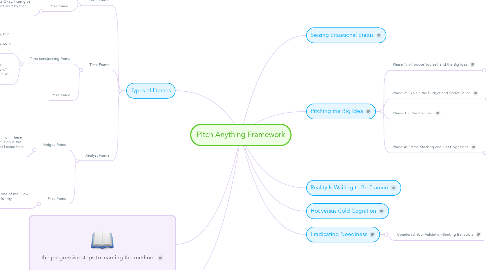
1. Types of Frames
1.1. Power Frame
1.1.1. Power-busting frame
1.1.2. Prize frame
1.1.2.1. “So you guys are asking me to delay the start? Okay. I can give you 15 minutes to get organized. But if we can’t start by then, then let’s just call it a day.”
1.1.2.1.1. And if he does not show at that point, you leave. You do not deliver your presentation, you do not leave brochures, and you do not apologize. Your time has been wasted, and you don’t even need to say it. They know
1.2. Time Frame
1.2.1. Time constraining frame
1.2.1.1. CUSTOMER: “Hi, yes, um, well, I only have about 10 minutes to meet with you, but come on in.”YOU: “No. I don’t work like that. There’s no sense in rescheduling unless we like each other and trust each other. I need to know, are you good to work with, can you keep appointments, and stick to a schedule?”
1.2.1.2. TARGET: “Thanks for coming over. I only have 15 minutes this afternoon.” YOU: “That’s okay, I only have 12.” You smile. But you are serious, too.
1.2.1.2.1. Perpetrate a small denial, or Act out some type of defiance.
1.2.2. Prize frame
1.3. Analyst Frame
1.3.1. Intrigue frame
1.3.1.1. “The revenue is $80 million, expenses are $62 million, the net is $18 million. These and other facts you can verify later, but right now, what we need to focus on is this: Are we a good fit? Should we be doing business together? This is what I came here to work on.”
1.3.1.1.1. It must be brief, and the subject must be relevant to your pitch. You need to be at the center of the story. There should be risk, danger, and uncertainty. There should be time pressure—a clock is ticking somewhere, and there are ominous consequences if action is not taken quickly. There should be tension—you are trying to do something but are being blocked by some force. There should be serious consequences—failure will not be pretty.
1.3.2. Prize frame
1.3.2.1. “So many buyers, yet only one of me. How are you going to compete for my attention.”
2. Seizing Situational Status
3. Pitching the Big Idea
3.1. Phase 1: Introduce Yourself and the Big Idea
3.1.1. The “Why Now?” Frame
3.1.1.1. Three-Market-Forces Pattern: Trendcasting
3.1.1.1.1. Introducing the Big Idea
3.1.1.2. The backstory of the idea is always interesting to the target.
3.2. Phase 2: Explain the Budget and Secret Sauce
3.2.1. What Is Attention?
3.2.2. Tension
3.2.2.1. Exemples
3.3. Phase 3: Offer the Deal
3.4. Phase 4: Frame Stacking and Hot Cognitions
3.4.1. Creating Hot Cognition
3.4.1.1. How to Stack Frames
3.4.1.1.1. Hot Cognition 1: The Intrigue Frame
3.4.1.1.2. Hot Cognition 2: The Prize Frame
3.4.1.1.3. Hot Cognition 3: The Time Frame
3.4.1.1.4. Hot Cognition 4: The Moral Authority Frame

